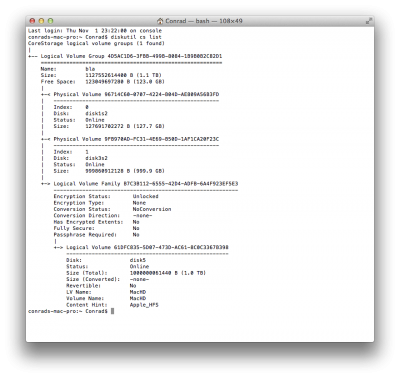Hi all,
I've been reading as much as I can on this topic: not only here at TonyMacX86, but also the Ars Technica article and of course the JollyJinx articles.
During all this reading I've come to the conclusion that speculation about what CoreStorage is doing is often based on other people's speculation and there have been a few "facts" presented which are in fact not authoritatively sourced (that I could find).
Does anyone know for a fact these assertions that I've read (I don't recall where now for each "fact", but these have been accumulating in my mind as needed evidence):
**ASSERTION 1: CoreStorage needs to know if one of the disks is SSD (via SMART via SATA) in order for Fusion to work**
This comes from the JollyJinx article where he states that he used a SATA connection so that CS could figure out there is an SSD there, but he doesn't state that it must know this in order for the Fusion Drive to work. Personally, I think Apple would have been rather short-sighted to require a particular technology or another to do something, I mean, why not just measure the performance of each physical disk in the set and if there is any large-enough disparity in READ performance, then do the Fusion thing.
**ASSERTION 2: Fusion will only work with 2 drives, no more**
Has anyone actually tried this? I would, but I only have a single extra physical disk lying around, let alone 3. If more than 2 drives are possible, and each have a different performance rating, will Fusion Drive allocate files to each accordingly?
**ASSERTION 3: PowerNap will not work with Fusion since PowerNap is disabled when there is a HDD**
This also seems rather silly to me. Sure, I understand that it takes too much power to fire up the old platter, but a Fusion drive has 4GB of "cache" that is written to first anyway, so, when power-napping, all the writes could happily go to the Fusion drive, then when there is power, these would be written to the HDD if required. Even the largest updates from Apple are smaller than 4GBs and most won't be applied until the user authorises it anyway. In fact, the more I think about it, I think Fusion Drive could be a way to bring PowerNap to more users.
**ASSERTION 4: System files always remain on the SSD**
I've seen people tossing this around based on something Phil said in the keynote, which was specifically: "The operating system entirely fits on that flash so we keep it there for maximum system performance. In fact all the software that comes preinstalled on your iMac fits in flash", he then goes on to make the case that if you don't use some of these programs (iMovie and iPhoto he specifies), they will get moved to HDD. Based on Phil's words, it should be the case that the core OS remains on the SSD, but utilities and programs could easily get moved to the HDD. So the big question is, how would this restriction be made? Does writing/updating system files mark a special flag on their blocks somehow? I speculate that in fact, this isn't happening at all, and that "system files" simply stay on the SSD simply because they are accessed frequently and thus remain there for the same reason any other frequently accessed file would. However, it would be nice if we have some authoritative source here (besides Phil Schiller in a keynote =).
It would be pretty sweet if there *was* some sort of mechanism to keep certain files on certain disks based on a policy though (and I hope my above speculation is wrong) because, in theory, Apple could conceivably allow the system to boot up (into Safe Mode, perhaps) even when the HDD fails, if it can keep the OS "locked" to the SSD. On the other hand, if such a policy-based mechanism exists, I am sure that some application developers will figure out how to exploit it so that their apps stay on the SSD so that they perform their best, which of course would defeat the purpose of Fusion Drive.
Anyway, anyone know any of these for sure?


